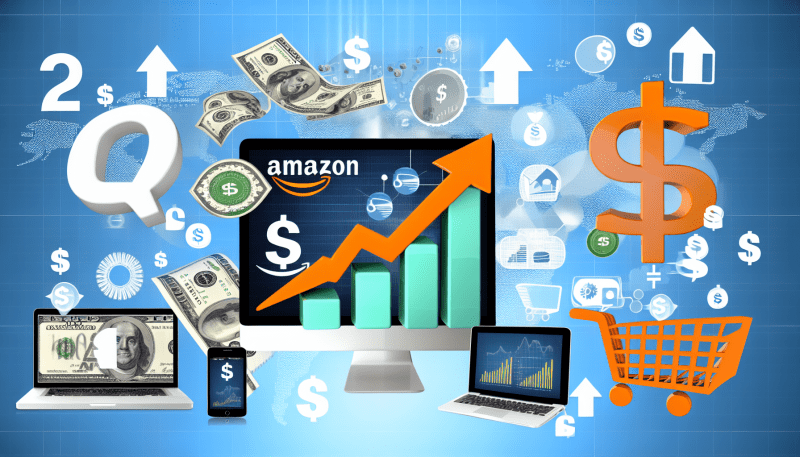If you're an Amazon seller looking to boost your profits, reselling might be a perfect opportunity for you. By purchasing products at low prices and selling them at higher prices, you can make a significant profit on Amazon. In this article, we'll explore the basics of reselling on Amazon, provide helpful tips on becoming a reseller, and offer insights into how to resell for profit effectively.
What Is Reselling on Amazon?
Reselling on Amazon is a business model where you buy products from various sources and then sell them at a profit on Amazon's marketplace. This can be a lucrative venture due to Amazon's vast customer base and relatively low entry barriers. However, success in reselling requires effort and research to find profitable deals while considering factors like competition and potential risks.
Types of Reselling on Amazon
There are four main Amazon reselling business models, each with its own approach to acquiring inventory: online arbitrage, wholesale, retail arbitrage, and dropshipping.
1. Online Arbitrage
Online arbitrage involves buying low-priced products from various online retailers and reselling them on Amazon for a profit. Key points to consider include:
- Fast Start, Low Investment: You can start quickly with minimal investment, usually within 2-3 months and as little as $500.
- Product Research: Thorough research is essential to find profitable products. Tools like Seller Assistant can help streamline this process.
- Product and Brand Restrictions: Some products require approval to sell, and some brands may have restrictions.
- Product Sourcing Tools: These tools can help identify profitable products and assess sales potential and restrictions. Seller Assistant is a top choice for such tools.
2. Wholesale
Wholesale reselling involves buying products in bulk directly from wholesalers or brands at a lower cost per unit. Key points include:
- High-Profit Potential: Buying in bulk allows for significant profits, but requires a larger initial investment.
- Supplier Relationships: Building relationships with suppliers is crucial to gain access to popular brands.
- Minimum Order Quantities (MOQs): Be prepared for substantial upfront investments due to high MOQs.
- Seller Tools: Tools like Seller Assistant can provide comprehensive data about potential product issues and profitability.
3. Dropshipping
In dropshipping, you don't hold any inventory. Instead, you work with a supplier who stores the products and fulfills orders. Key points include:
- Low Barrier to Entry: Easy to start as you don’t need to manage inventory.
- Amazon's Dropshipping Policies: You must be identified as the seller and handle all product documentation.
- Intellectual Property Concerns: Be aware of potential IP complaints from brands. Seller Assistant’s IP Alert feature can help avoid these issues.
- Supplier Selection: Choosing reliable suppliers is crucial to ensure product quality and timely delivery.
4. Retail Arbitrage
Retail arbitrage involves finding deals on products at brick-and-mortar stores and reselling them on Amazon. Key points include:
- Easy to Start: Requires minimal technical expertise and low startup costs, potentially starting at around $500.
- In-Store Research: Product research is done physically in stores using barcode scanning apps.
- Time Commitment: Requires significant time investment as you need to travel to stores and replenish inventory physically.
How Does Reselling on Amazon Work?
Reselling on Amazon involves a few key steps regardless of the reselling model you choose. Here’s a step-by-step breakdown:
Step 1: Finding Products
Research and identify products that are in demand and can be resold for a profit. Use tools like Seller Assistant to streamline product selection and quickly identify profitable deals.
Step 2: Sourcing the Products
Find reliable suppliers to purchase your chosen products. This could be wholesalers, retail stores with discounts, other online marketplaces, or even liquidators. Seller Assistant’s Quick Links and Side Panel View features can help you find suppliers efficiently.
Step 3: Listing a Product on Amazon
Once you have the products, list them on Amazon. Make sure your product matches the one on Amazon exactly to avoid issues.
Step 4: Fulfilling Orders
When a customer buys your product, handle the order fulfillment. You can package and ship the product yourself or use Amazon's FBA (Fulfillment by Amazon) service, where they handle storage, packaging, and shipping for a fee. For dropshipping, the supplier handles fulfillment.
How to Find the Best Items to Resell on Amazon
Finding the right products to resell is crucial for success. Here are some steps to guide you through the product research process using Seller Assistant:
1. Clean Product Link
Remove the referral code from the product link to get accurate information.
2. Private Label Brand Check
Avoid private label brands that might file intellectual property complaints. Seller Assistant’s IP Alert feature can help identify these issues.
3. Check Competition by FBA Seller Count
Analyze the number of FBA sellers to gauge competition. Ideally, there should be 3-15 sellers for balanced competition.
4. Identify Amazon as a Seller
Avoid products where Amazon is a dominant seller. Seller Assistant highlights these products with a red Amazon icon.
5. Check Listing Age
Choose products with listings at least six months old to analyze sales history.
6. Find Product Demand by Best Sellers Rank (BSR)
Lower BSR indicates better sales. Analyze the average BSR over 90 days for trends. Seller Assistant provides this data along with estimated monthly sales.
7. Buy Box Analysis
Use Buy Box offers to set your pricing strategy. Seller Assistant shows Buy Box trends and pricing information.
8. Study Variation Compliance
Ensure product variations comply with Amazon's guidelines. Seller Assistant's Variation Viewer can help analyze variations.
9. Look at Product Reviews
Check for products with good reviews (4-5 stars). Avoid products with excessive negative reviews. Keepa charts within Seller Assistant display review data.
10. Verify Selling Eligibility and Restrictions
Check if the product requires approval for sale. Seller Assistant shows this information with lock icons for approved or restricted products.
11. Check for Product Flags
Be aware of flags like oversized or fragile items. Seller Assistant highlights these flags on product and search pages.
12. Assess Estimated Sales
Estimate how many units you can sell monthly. Seller Assistant provides sales estimates for each product.
13. Calculate Product Profitability
Aim for a Return on Investment (ROI) above 10%. Use Seller Assistant's profit calculator to quickly assess ROI.
4-Step Supplier Search with Seller Assistant
After researching products, secure a reliable supplier at a competitive price. Here’s how Seller Assistant can help:
Step 1: Launch Your Product on Amazon
Find your chosen product on Amazon and open Seller Assistant.
Step 2: Explore Supplier Options
Select a supplier website from Seller Assistant’s drop-down list, including options like Google Shopping, eBay, Walmart, and more.
Step 3: Redirect to Search Results
Choose a supplier, and Seller Assistant will redirect you to the search results page for your product.
Step 4: Research and Select a Supplier
Use the Side Panel View in Seller Assistant to compare product data on Amazon and the supplier’s site. Calculate profitability to make informed decisions.
Can You Make Money Reselling on Amazon?
Yes, it is possible to make money reselling on Amazon. However, success requires hard work, dedication, and a solid strategy. Research and choose the right products, find reliable suppliers, and identify profitable deals. Tools like Seller Assistant can simplify the process, helping you make informed decisions and maximize profits.
FAQ
How to become a reseller on Amazon? Register for a seller account, source in-demand products at low costs, and list them on Amazon for profit. Thorough product research with tools like Seller Assistant is key to success.
How to buy and resell on Amazon? Find in-demand products with good profit margins, buy them low (wholesale, clearance), and resell them higher on Amazon. Be strategic about pricing and competition.
Is it legal to resell products on Amazon? Yes, reselling on Amazon is legal if you buy items through legitimate channels and comply with Amazon's seller policies.
What is an Amazon reseller? An Amazon reseller buys products from various sources at low prices and sells them for profit on Amazon.
Final Thoughts
Reselling on Amazon offers a potential path to profitability, but long-term success depends on effective product sourcing strategies. Product sourcing tools like Seller Assistant can help you find winning products and streamline the process. With features like Side Panel View, profit calculators, and comprehensive data insights, Seller Assistant enables you to make informed decisions and select high-margin items for your store.







